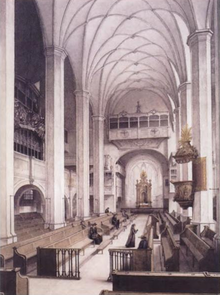Loading AI tools
From Wikipedia, the free encyclopedia
Meine Seufzer, meine Tränen (My sighs, my tears),[1] BWV 13, is a church cantata by Johann Sebastian Bach. He composed it in Leipzig for the second Sunday after Epiphany and first performed it on 20 January 1726.
| Meine Seufzer, meine Tränen | |
|---|---|
BWV 13 | |
| Church cantata by J. S. Bach | |
 Thomaskirche, Leipzig | |
| Occasion | Second Sunday after Epiphany |
| Cantata text | Georg Christian Lehms |
| Chorale |
|
| Performed | 20 January 1726: Leipzig |
| Movements | 6 |
| Vocal | SATB soloists and choir |
| Instrumental |
|
Bach wrote the cantata in his third year in Leipzig for the Second Sunday after Epiphany.[2] The prescribed readings for the Sunday were taken from the Epistle to the Romans, we have several gifts, each is unique, as part of the body of Christ (cf also I Corinthians 12)(Romans 12:6–16), and from the Gospel of John, the Marriage at Cana (John 2:1–11). The text is taken from Georg Christian Lehms' annual of cantatas, published in Darmstadt in 1711. The single idea from the gospel is the word of Jesus: "Mine hour is not yet come". The text is divided into two parts of three movements each, the first dealing with the distress of someone feeling abandoned, the second with hope for God's help. Both parts are closed by a chorale. Movement 3 is the second stanza of Johann Heermann's hymn "Zion klagt mit Angst und Schmerzen",[3] the closing chorale is the final stanza of Paul Fleming's "In allen meinen Taten".[4] According to Alfred Dürr, it is unlikely that they were performed before and after the service, considering the brevity of the work.[2]
The cantata in six movements is intimately scored for four soloists, soprano (S), alto (A), tenor (T), and bass (B), a four-part choir (SATB) in the chorales, two recorders (Fl), oboe da caccia (Oc), two violins (Vl), viola (Va), and basso continuo.[2] The continuo is playing throughout.
| No. | Title | Text | Type | Vocal | Winds | Strings | Key | Time |
|---|---|---|---|---|---|---|---|---|
| 1 | Meine Seufzer, meine Tränen | Lehms | Aria | T | 2Fl Oc | D minor | 12/8 | |
| 2 | Mein liebster Gott läßt mich annoch | Lehms | Recitative | A | ||||
| 3 | Der Gott, der mir hat versprochen | Heermann | Chorale | A | Fl Oc | 2Vl VA | F major | |
| 4 | Mein Kummer nimmet zu | Lehms | Recitativo | S | ||||
| 5 | Ächzen und erbärmlich Weinen | Lehms | Aria | B | Fl | solo violin | G minor | |
| 6 | So, sei nun, Seele, deine | Fleming | Chorale | SATB | Fl Oc | 2Vl VA | B-flat major |
The cantata is opened by an aria, a lamento accompanied by soft recorders and the dark sound of the oboe da caccia which leads frequently. It is a da capo form, but the middle section is again divided in two parts. In it, the voice shows the "Weg zum Tod" (road to death)[1] by several downward steps.[2] Dürr points out that this composition "illustrates how the imagination of the Baroque musician is particularly fired by texts dealing with sighing and pain".[5] The following short secco recitative ends as an arioso on the words "vergebens flehen" (plead in vain).[1] In the chorale, the woodwinds play the cantus firmus in unison with the alto voice, while the strings play independent figuration in F major, illustrating hope, although the text says that hope is not yet in sight. John Eliot Gardiner describes the "confident diatonic harmonies" as an "optimistic, wordless answer" to the voice's "prayer for comfort".[5]
A second expressive recitative leads to a second aria, which is accompanied by violin I and the recorders, playing in unison an octave higher. The lamenting text of the beginning "Ächzen und erbärmlich Weinen" (groaning and pitiful weeping)[1] is stressed by intervals such as augmented second, diminished fifth and diminished seventh. The ritornello has two distinctly different parts, a lamenting section and a hopeful one, full of fast runs and passages. In the middle section, the text "wer gen Himmel siehet" (he who looks towards heaven)[1] is accented by an octave leap upwards in the voice and upwards runs in the instruments, contrasting the downward line in movement 1. The closing chorale is a four-part setting of the melody of "O Welt, ich muss dich lassen" by Heinrich Isaac, which is featured twice in Bach's St Matthew Passion in movements 10 (Ich bin's, ich sollte büßen) and 37 (Wer hat dich so geschlagen).[2][6]
Seamless Wikipedia browsing. On steroids.
Every time you click a link to Wikipedia, Wiktionary or Wikiquote in your browser's search results, it will show the modern Wikiwand interface.
Wikiwand extension is a five stars, simple, with minimum permission required to keep your browsing private, safe and transparent.